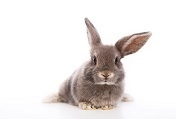
What is the moulting process in rabbits, guinea pigs, chinchillas and degus?
The time of shedding has also begun for rabbits...
Moulting season has also begun for rabbits; twice a year, rabbits change their coat in adaptation of the changing seasons. A rabbit’s thicker winter coat protects it from the cold and prevents energy loss. When the temperatures rise again, this thick coat makes it difficult for the skin to release heat into the environment. The rabbit then sheds this coat for its summer coat for the warmer months of the year. Moulting is subject to a complex hormonal interplay. The body’s metabolism must work harder. Moulting can be prolonged during fluctuating temperatures, sometimes lasting several months. Most healthy rabbits go through moulting without any problems. Older, sick or weak animals may have issues, however.Moulting can be greatly supported through high-quality, species-appropriate feed. The basis of every feed should be a high-quality roughage, for example Wiesenheu.
This base feed can be supplemented with AGROBS Gartenschmaus, a delicious composition of root vegetables, leaves, flowers and rose hips that is not only tasty but also healthy and naturally rich in vital substances.
Nagerbits are especially suitable for rabbits with increased energy requirements. Nagerbits provide sufficient energy and essential fatty acids, which are important for skin and coat quality as well as for the immune system, through linseeds.
Ringelblumenblüten are not only healthy and popular treats – marigold is also said to have beneficial effects for the skin.
In addition to providing high-quality feed, rabbits should also be brushed regularly during moulting to remove loose tufts of fur.
What is the moulting process in rabbits, guinea pigs, chinchillas and degus? Unlike rabbits, one can observe a constantly diffuse shedding in guinea pigs, chinchillas and degus. An unusually large loss of fur is to be regarded as a sign of disease caused by parasites, hormonal disturbances or faulty husbandry. Noticeable changes in the coat should be examined by a competent veterinarian.
Guinea pigs, chinchillas and degus, unlike rabbits, have no defined moulting “season”. These animals experience moulting according to a regular process: the hairs grow until they have reached the length typical for the animal (= hair growth phase). This is followed by a dormant phase until the growing hairs loosen the old hairs in their follicles, causing them to fall out. Chinchillas can shed tufts of hair when stressed.
In extreme cases, it can take several months until the hairs grow back. This mechanism allows the animals a quick escape if attacked.
Chinchillas and degus should be provided with sand baths so that they can clean themselves regularly. Without the opportunity for sand baths, the coats of chinchillas and degus will become greasy. It can also lead to matting and hair breakage in chinchillas.
We recommend AGROBS Naturmix for Degus and Chinchillas. AGROBS Naturmix is a mixture of meadow grasses, herbs, flowers, roots and seeds that's high in crude fibre and low in sugar, and which corresponds to the natural nutritional needs of these animals.
Dr. med. vet. Katharina Boes
September 2015 ©AGROBS GmbH
Sources*:
September 2015 ©AGROBS GmbH
- A. Ewringmann, B. Glöckner: Leitsymptome bei Meerschweinchen, Chinchilla, Degus. Enke Verlag Stuttgart, 2012
- A. Ewringmann: Leitsymptome beim Kaninchen. Enke Verlag Stuttgart, 2005
- S. Steinlechner: Endokrine Mechanismen bei der jahreszeitlichen Klimaanpassung. AHMN Endokrinologie, 2009



